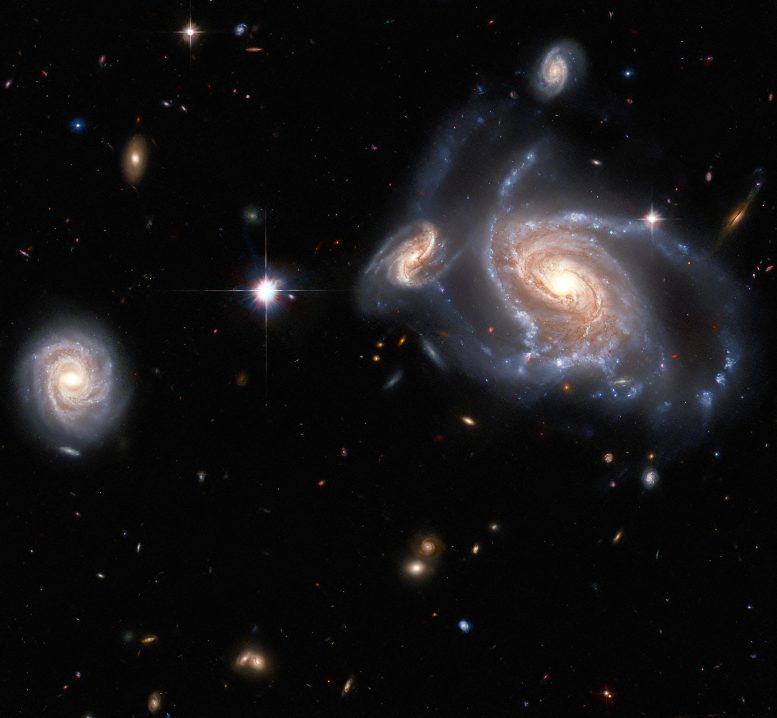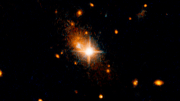
Hubble Space Telescope image featuring the spiral galaxies NGC 1356, LEDA 467699, LEDA 95415, and IC 1947. Credit: ESA/Hubble & NASA, J. Dalcanton, Dark Energy Survey/DOE/FNAL/NOIRLab/NSF/AURA, Acknowledgment: L. Shatz
This Hubble Picture of the Week features a richness of spiral galaxies: the large, prominent spiral galaxy on the right side of the image is NGC 1356; the two apparently smaller spiral galaxies flanking it are LEDA 467699 (above it) and LEDA 95415 (very close at its left) respectively; and finally, IC 1947 sits along the left side of the image.
This image is a really interesting example of how challenging it can be to tell whether two galaxies are actually close together, or just seem to be from our perspective here on Earth. A quick glance at this image would likely lead you to think that NGC 1356, LEDA 467699, and LEDA 95415 were all close companions, while IC 1947 was more remote. However, we have to remember that two-dimensional images such as this one only give an indication of angular separation: that is, how objects are spread across the sphere of the night sky. What they cannot represent is the distance objects are from Earth.
For instance, while NGC 1356 and LEDA 95415 appear to be so close that they must surely be interacting, the former is about 550 million light-years from Earth and the latter is roughly 840 million light-years away, so there is nearly a whopping 300 million light-year separation between them. That also means that LEDA 95415 is likely nowhere near as much smaller than NGC 1356 as it appears to be.
On the other hand, while NGC 1356 and IC 1947 seem to be separated by a relative gulf in this image, IC 1947 is only about 500 million light-years from Earth. The angular distance apparent between them in this image only works out to less than four hundred thousand light-years, so they are actually much much closer neighbors in three-dimensional space than NGC 1356 and LEDA 95415!









The topography of the universe over time and how it changes nothing but our perceptions.
If dark matter changes states between a liquid and gaseous state then there would have been a time where almost all of the dark matter cooled, condensed and collapsed. This liquid state contraction could possibly have led to direct collapse black holes and galaxies. The condensing of dark matter may have also contributed to that uniformity of temperature.
If the dark matter was in its liquid state then baryonic and dark matter would have been much more concentrated. This would have resulted in deeper gravity wells. The time in these gravity wells to us would seem to be moving slower to us. But due to dark matter condensing the baryonic matter would also have been cooled and rushing together.
Once stars were formed and black holes became active the ratio of liquid to gaseous dark matter would have decreased over time thus affecting the evolution of particle masses. And making the gravity wells progressively shallower and larger in diameter over time. Galaxy clusters would have evaporated almost all of their liquid dark matter resulting in the shallowest part of the gravity well being near the canter of the cluster. Also part of redshift is due to the difference depth of the average gravity well at that point in time compared to now. The slope of that line would also have flattened over time.
The CMB could also be from when the LDM ratio drops to low in the cosmic web to transmit Baryonic acoustic waves
Light red shifts as it climbs out of a gravity well. Thus the further you go back in time the more light is redshifted. This would leave everything the same with the exception of our perception that the universe is expanding. Also if a big portion of the redshift is from climbing out of a deeper gravity well then we are not looking as far into the past as we think.
Phase transitioning dark matter could also answer several of the biggest questions in cosmology.
The amount of sheer ignorance and stupidity sprinkled with random scientific terms in this post is just astounding and record-setting.
As some of the sharpest images of distant galaxies I recall ever seeing, if the photo wasn’t ‘enhanced’ in any way then the focus of the Hubbell telescope is more amazing than I previously thought. However, if one wants to more accurately determine the distances between those galaxies and the earth they still need to recognize gravity as locally generated, radiant, pulsing, angular lines of attractive force which, as indicated for with ‘gravity lensing,’ cause photons to accelerate, line-to-line of gravity force (blue shift) upon leaving their sources followed with decelerating line-to-line of gravity force (red shift) as they arrive to near earth vicinity. The initial misinterpretation of the scattering of dots in the early double-slit experiments has skewed all of astronomy and physics ever since.
Please talk about country music. That’s probably a topic you understand.
What TheHeck? Since 2012 I’ve been demonstrating and explaining my rather unique lay findings on gravity with this (https://odysee.com/@charlesgshaver:d/1Gravity:8) and other videos, and commenting on various websites (including my own; retired). Can you prove, as opposed to merely ‘imply,’ I’m wrong? If so, let’s get it done so I don’t risk leading a generation of budding young scientists astray.
Two shekels says TheHeck is talking to another sockpuppet most of the time. Typical Classic fascist mob tactic.
The large galaxy has two broad darkened arcs of fairly constant width, like two pieces of a black broken “O,” the overall effect is of a disrupted galactic quantum gravitational wavelet.
I suppose the width of these features is the same as the spacing between the orange “dark matter” effect rings, ~30K light-years, here:
https://scitechdaily.com/cosmic-clarity-gravitational-lensing-reveals-the-fine-fabric-of-dark-matter/
From google: “Planck’s constant, symbolized as h, is a fundamental universal constant that defines the quantum nature of energy and relates the *energy* of a photon to its frequency.”
A photon with a wavelength (rotation period) of 30K light-years would have an energy of (rough guess) 10^-21 Watts. As EM between protons is 10^36 times stronger than the gravity between protons, the rotational energy of a gravity field carrier with a field effect angular rate of 30K light-years looks like it’s maybe 10 to the -57 Watts. Thet’s a remarkably low amount of energy by any measure.
Oops, plugged in 10^12 cycles/second instead of 10^-12 cycles/second:
20,000 light-years/wave-cycle is ~10^-12 wave-cycles/second
(~10^-33 Joule-seconds)x(~10^-12 cycles/second)x(10^-36 G/E force ratio) =
10^-81 Joules = 10^-81 Watt-seconds
Reducing some of the round-up error a little more:
(10^21 meters)/(3×10^8 meters/sec) = 3.3×10^12 sec
(6.6×10^-34 Joule-seconds)/(3.3×10^12 seconds/cycle) = 2×10^-46 Joules
(2×10^-46 Joules)x(10^-36) = 2×10^-82 Joules
10^21 meters is about 100k light-years distance, and that number is supposed to match well with effective proton diameter multiplied by dimensionless E/G force ratio for protons.
“10^21 meters is about 100k light-years distance, and that number is supposed to match well with effective proton diameter multiplied by dimensionless E/G force ratio for protons.”
Better values may reduce the proton size for a distance shorter than 100K light years.
Gravity is a vector (force) field in this scenario and the vector carrier is modeled as a spherical particle capable of exerting pull on contact with one particle face (side) of interaction contact and push through the other face.
Vector field carrier particle by that scheme is spin-1, gravity appears spin-2, so a bi-vector (opposed vector-pair) particle pair superposition is the obvious way to make it spin-2. Since the spin spin-2 field carrier rotates at twice the rate of the spin-1 carrier, the ~100k light-year figure gets cut by 2 down to ~50K light-years size wave-cycle effect. For a long time I vacillated deciding between the two spin modes. I’ve preferred thinking in terms of spin 2 pairings mostly recently, for a quantum gravity wavelength close to 50k light-years. Now I guess the ALMA tomographic slice data citing a 30k light year feature should clinch it for the spin 2 scheme.
One thing that I’ve noticed emerging from such models is that bent fields likely fit a quantum sized subspace (if anywhere) far better, more realistically, compared to GR’s bent macro-space hiding a lack of gravitationally bent time, missing a nonconstant gravity-sensitive vacuum light-speed. Toward that, the obvious way to model interactions with matter and such gravity carriers is to suppose carrier contact may disrupt the carrier, where the carrier energy then dissipates in a quantum stress tensor effect.
A further interaction concept, one that may add to binding without necessarily pulling particles closer together (but keeping cold nucleons locked in sync) eventually emerged, this one involving cold nucleons and realistic ways of modeling the dynamics of retro-reflecting the carrier on contact. The most obvious retro-reflective mechanisms seem to enable a Hebbian-type of learning process evolving between cooled nucleons and annealing in nucleon networks.
I suppose the idea was destined to drive fascist political hacks (The Heckster, a troll always living under a bridge nearby, being a perfect example) into agony with a better idea than religious cronyism for explaining the meaning of life. It’s ALWAYS a solid winning philosophy to annoy religious fascists, frankly, and my designs only improve.
An even more enjoyable positive anti-fascist bonus is revealing the simplest mechanism for using gravity to avoid the depressing effects of universal heat death. That universal escape hatch is simply, again, cold matter retroreflective focus. The site’s unofficial internet fascist troll puppet-master bridge is likely burning at full pace with that. I’ll discuss a good model for nucleon internal dynamics in gravity carrier retro-reflections later.
Trolls object to tight syntax before they flip out into complaining about the opposite if appeased. Religious science trolls (fascists) are just that sort of garbage and much much more awaits revealing in their scripted multiverse (think of MOND as fascist ethnic gravity FOMO), of course.
Einstein’s most globally ambitious psychotic fans always try to hide all of that, so again: *Never Forget*
Best evidence for cold matter retro-refection:
(1) Roughly octahedral cold-packed asteroid “Bennu.”
(2) Roughly octahedral cold-packed asteroid “Ryugu.”
(Clincher #3?) Roughly square AZ crater entry hole now being argued by others as being formed by a roughly octahedral cold-packed asteroid.
The gigantic sinusoidal ripple evident in the side view of BRI 1335-0417, also revealed by ALMA and in the news this month, a galaxy which is said to be the oldest spiral galaxy currently known, presumably has the same wave-scale of ~30k light-years.